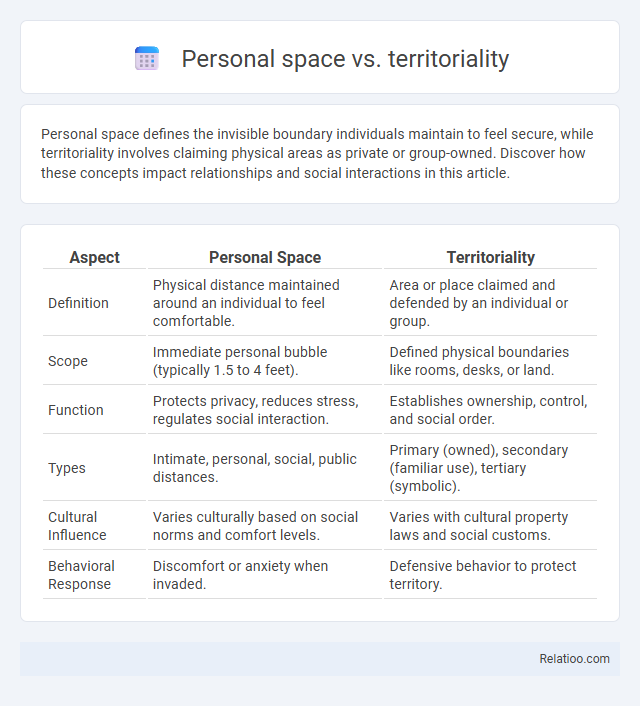Personal space defines the invisible boundary individuals maintain to feel secure, while territoriality involves claiming physical areas as private or group-owned. Discover how these concepts impact relationships and social interactions in this article.
Table of Comparison
| Aspect | Personal Space | Territoriality |
|---|---|---|
| Definition | Physical distance maintained around an individual to feel comfortable. | Area or place claimed and defended by an individual or group. |
| Scope | Immediate personal bubble (typically 1.5 to 4 feet). | Defined physical boundaries like rooms, desks, or land. |
| Function | Protects privacy, reduces stress, regulates social interaction. | Establishes ownership, control, and social order. |
| Types | Intimate, personal, social, public distances. | Primary (owned), secondary (familiar use), tertiary (symbolic). |
| Cultural Influence | Varies culturally based on social norms and comfort levels. | Varies with cultural property laws and social customs. |
| Behavioral Response | Discomfort or anxiety when invaded. | Defensive behavior to protect territory. |
Understanding Personal Space
Understanding personal space involves recognizing the invisible boundary individuals maintain to feel comfortable and secure, differing from territoriality, which relates to the physical areas owned or controlled. Personal space varies based on cultural norms, social context, and individual preferences, influencing how you interact and communicate effectively. Distancing, often a response to threats or discomfort, helps regulate personal space and maintain psychological well-being.
Defining Territoriality
Territoriality refers to the behavioral pattern where individuals or groups claim and defend a physical space to establish ownership and control, often marked by boundaries or symbols. Unlike personal space, which is an invisible buffer zone surrounding a person, territoriality involves a more permanent area used for activities like living, working, or socializing. Distancing focuses on the physical or psychological separation individuals maintain to regulate social interaction, whereas territoriality emphasizes control and possession of specific locations.
Key Differences between Personal Space and Territoriality
Personal space refers to the invisible boundary individuals maintain around themselves to feel comfortable during social interactions, while territoriality involves the physical spaces or areas people claim and defend as their own. Personal space is dynamic and varies depending on relationship closeness and cultural norms, whereas territoriality is more static, often linked to ownership or control over a particular environment. Distancing typically relates to maintaining space for psychological comfort or safety, intersecting with both personal space and territoriality but emphasizing deliberate separation.
Psychological Foundations of Personal Space
Personal space is a psychological buffer zone essential for emotional comfort and stress reduction, differing from territoriality, which involves ownership and control over a physical area. Psychological foundations of personal space emphasize innate needs for security and autonomy, deeply rooted in evolutionary survival mechanisms and social learning. Understanding these concepts helps you navigate social interactions by recognizing how personal boundaries influence behavior and emotional well-being.
Types and Zones of Territoriality
Territoriality encompasses several types, including primary territories like a person's home, secondary territories such as a workplace or social hangout, and public territories like parks or streets, each with distinct levels of control and attachment. Zones of territoriality are physical or social spaces defined by boundaries, including intimate, personal, social, and public zones, which regulate proximity and interaction based on cultural and contextual factors. Unlike personal space, which is an invisible buffer individuals maintain around themselves for comfort, territoriality involves the active claiming and defense of physical locations or objects.
Cultural Influences on Spatial Behavior
Cultural influences significantly shape personal space, territoriality, and distancing behaviors, dictating how individuals perceive and maintain physical boundaries in social interactions. In collectivist cultures, close proximity and overlapping personal spaces are common, while individualistic societies often prioritize larger personal zones and clear territorial demarcations. These spatial preferences impact communication, social norms, and conflict resolution strategies across diverse cultural contexts.
Personal Space in Social Interactions
Personal space in social interactions refers to the physical distance individuals maintain to feel comfortable and secure. This invisible boundary varies based on cultural norms, relationship types, and context, influencing communication and emotional responses. Violations of personal space can lead to discomfort, anxiety, or perceived threats, highlighting its crucial role in nonverbal communication and social dynamics.
Territoriality in Public and Private Settings
Territoriality in public settings involves individuals or groups marking specific spaces to establish control, often using physical boundaries, personal belongings, or social norms to signal ownership and limit access. In private settings, territoriality manifests more rigidly through property rights, personalized spaces, and exclusivity, reinforcing a sense of security and identity. Understanding these distinctions helps manage interpersonal behaviors and spatial conflicts effectively in varied environments.
Impacts of Violating Personal Space and Territories
Violating personal space or territorial boundaries can trigger stress, anxiety, and aggressive behavior due to perceived threats to safety and autonomy. Your discomfort and decreased sense of control may lead to impaired communication and damaged relationships. Understanding these psychological impacts helps maintain respectful interactions and promotes emotional well-being.
Strategies for Respecting Boundaries
Respecting boundaries involves recognizing personal space as the immediate area surrounding an individual, requiring sensitivity to body language cues that signal comfort or discomfort. Territoriality pertains to owning or controlling specific spaces, necessitating clear communication and respect for signage or social norms to avoid intrusion. Distancing strategies include maintaining appropriate physical gaps in social and professional settings, adapting to cultural variations in space preferences to foster positive interactions and avoid conflict.

Infographic: Personal space vs Territoriality
 relatioo.com
relatioo.com